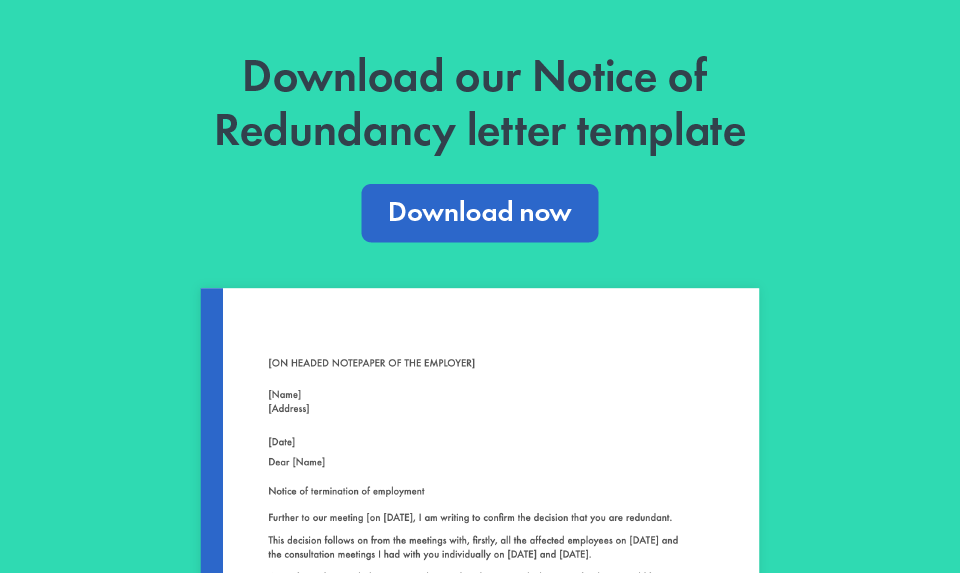

Letting people go is always a bad situation - both for you and for the person being dismissed.
If you’re making people redundant, you’re likely worried not just for the future of your organisation, but for the wellbeing of your fellow team members, the people you work side-by-side with every day.
I know the pain of having to have difficult conversations with friends and co-workers who I like and respect. It’s hard to strike a balance between doing things by the book, and being fair to your team members while also doing what’s right for the survival of the organisation as a whole.
To help you navigate this challenge, I’d like to offer some recommendations about how to frame your redundancy letter templates in accordance with UK employment law.
The purpose of your redundancy letter is to inform your team members their role is being made redundant and their services are no longer required. This is different from termination or other kinds of dismissal, in that the employee is being let go through no fault of their own.
Your redundancy letter provides unambiguous reasons for the employee's redundancy, the details of any severance package, and a timeline for the employee's dismissal. It's a piece of business communication that carries significant weight, both emotionally and legally.
The redundancy letter also helps ensure legal compliance and protects you from potential wrongful termination disputes. UK employment law has specific requirements for redundancies, which extends to how and when employees ought to be informed.
Finally, your redundancy letter also plays a central role in your redundancy process. It provides a written record that can be referred to in case of future disputes or disagreements.
Redundancy is a multi-step process - employees can't just be let go at will without reason. Different types of redundancy letters ensure a fair and transparent process:
This is a general mass communication - and the first step in the process - that is sent out when an organisation is considering making redundancies. It informs employees that their roles are at risk.
This allows the employee to prepare for the possibility of redundancy, engage in the redundancy consultation process, and look for other opportunities if necessary.
Download our free at risk-of-redundancy letter template here below:

This is the last and most painful stage - the redundancy notice letter sent to inform the employee that their position has been made redundant. This is after the consultation when the decision has already been made.
The letter offers the employee the details of the redundancy, the reasoning behind the decision, any remaining pay the employee is entitled to, and their final date of employment.
You can download our notice of redundancy letter template here below:

Writing a redundancy letter is a delicate and sensitive task. It requires empathy, tact and clear communication.
The redundancy letter you write should be professional, respectful, kind and compliant with the law. Here are some things to consider including as you write your redundancy letter:
Your employee’s redundancy letter should clearly state the reason for the redundancy - whether due to business conditions, organisational restructuring or closure of the business.
Giving an unambiguous window into the decision-making process behind the redundancy drives home the point that the decision is not personal, and is not related to the employee's performance.
The letter should also tell the employee how long they will have before their employment ends. This should adhere to the terms of the employee’s contract or statutory requirements. This gives them a clear timeline so they can plan for their next steps.
If the employee is entitled to payment in lieu of notice (PILON), the letter should tell them when and how much they will be paid.
The PILON payment is usually made when the employer wants to end the contract immediately, without having to wait out the notice period. Giving the employee this info makes the process more transparent and helps them to understand their financial situation.
There’s a lot that can go wrong when informing employees of their redundancy, especially if you’re handling the process on your own without professional counsel.
Here are some common pitfalls to look out for:
Handling redundancies is a complicated and messy process that demands a thorough understanding of UK employment law, a compassionate and kind approach, and meticulous attention to detail.
Having a professional give you an extra set of eyes can make all the difference in the success of your redundancy process.
I and the other HR professionals at CharlieHR offer a tailored HR advice service that can guide you through the difficult redundancy process.
Our CIPD-qualified advisors can help you:
Redundancies are challenging, both procedurally for your business, and emotionally for you and your team members. A well-structured redundancy process can help you navigate that process with confidence and fairness.
Using redundancy letters and handling the process correctly isn't just about staying above board concerning the law - but about supporting your team members during a difficult time.
Book a call with one of our HR advisors today, and we’ll help you turn a challenging situation into an opportunity for compassionate leadership and growth.

Want to find more HR templates like this one?